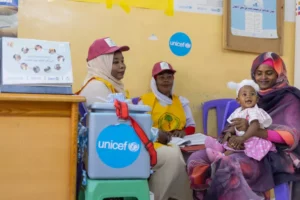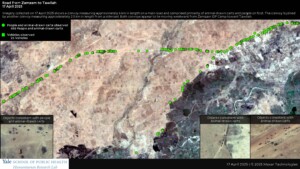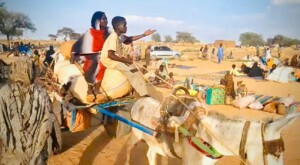Sudan OCHA bulletin 14: High prices impact household purchasing power
Deteriorating macroeconomic conditions, including devaluation of the local currency and high inflation continue to erode household purchasing power in Sudan.

Deteriorating macroeconomic conditions, including devaluation of the local currency and high inflation continue to erode household purchasing power in Sudan.
In its latest humanitarian bulletin, the UN Office for the Coordination of Humanitarian Affairs (OCHA) in Sudan quotes the latest Key Message Update of FEWS NET. On average, cereal prices increased up by 20 per cent across markets between May and June 2018. These increases are attributed to seasonably tightened market supplies, seasonal increased demand for local consumption and cross-border trade, and extremely high costs of transportation. Sorghum and millet prices are about 200 per cent above the five-year average, says FEWS NET.
Through September, poor households in areas of North Darfur and Kassala states— affected by severe dryness in 2017—refugees from South Sudan, and poor households in northern parts of Red Sea and North Kordofan states are expected to slide to Crisis, equivalent to Integrated Food Security Phase Classification (IPC) Phase 3, says FEWS NET. FEWS NET defines IPC Phase 3 as when 20 per cent of families in an area have limited access to food with high or above average malnutrition rates reported. However, food security is likely to improve after the October harvest, and most parts of Sudan will return to Minimal (IPC Phase 1) or Stressed (IPC Phase 2) levels.
Above-average rainfall to date has favored crop development and pasture regeneration. The exception is in some areas in northern Kassala, East Darfur, parts of West Kordofan, and South Kordofan states—where rainfall has been below average—leading to delayed crop establishment, i.e. the percentage of sown seed that goes on to produce plants. Meanwhile, heavy rain has caused localized flash flooding in some areas of West Kordofan, Kassala, Blue Nile, Sennar, West and Central Darfur states.
Ravaged by a household fire, IDPs in Darfur turn to a national partner for assistance
When an unattended cooking fire spread last April across a section of El Neem internally displaced persons (IDP) camp in East Darfur, 1,888 families lost all their possessions. Intensified by wind, the flames quickly spread through the homes, which were closely clustered with little or no space or roads between blocks. To assist the victims and introduce a more robust anti-fire culture, United Peace Organization (UPO), a national non-governmental organization (NGO) has initiated a programme in El Neem, including improved emergency shelter materials; improved shelter construction techniques; and fire prevention awareness.
With $320,000 funding from the USAID Rapid Response Fund (RRF), so far 714 families have received improved emergency shelter materials, 400 of whom have already built new homes. Under the programme, 100 youth volunteers – 35 per cent women – have received training on fire prevention, control and risk management, and fire-proof shelter construction. Working together with affected people, the youth volunteers extended their training to 5,700 women and girls, who undertake most of the cooking in their households. With training on fire prevention and control, and risk management, the youth volunteers, and the women and girls have held about 50 fire awareness, prevention and planning and action sessions in the camp. So far, they have reached 50,000 people, and plan to cover the whole camp population of about 92,000 people.
The trainings have enabled about 2,000 families to take preventative steps against fire, including building small walls from soil within the kitchen area to reduce direct contact with flammable materials; and setting up kitchens separately from the living quarters. The UPO response activities will continue until 25 September 2018, restoring the dignity and reducing the stress from this traumatic incident.
High malnutrition rates reported across refugee camps in White Nile State
In its latest South Sudanese refugee response update, the UN Refugee Agency (UNHCR) says that preliminary results for the Standardized Expanded Nutrition Survey (SENS) in White Nile State indicate critical—above 15 per cent—global acute malnutrition (GAM) levels in refugee camps. Key drivers of the malnutrition include food insecurity and nutrition programme gaps, including both curative and preventive interventions.
While the UN Children’s Agency (UNICEF) is leading a ‘find-and-treat’ initiative to ensure at-risk children are identified and enrolled in camp nutrition programmes, the World Food Programme (WFP) has prioritized food distribution and preventive and curative nutritional supplements for children aged 6-59 months. In addition, they are targeting breastfeeding mothers and pregnant women with blanket supplementary feeding programme and a curative programme for persons of concerns with moderately acute malnutrition (MAM).
The SENS was carried out jointly by UNHCR, UNICEF, WFP, World Health Organization (WHO), the State Ministry of Health (SMoH), the government’s Commission for Refugees (CoR), the Humanitarian Aid Commission (HAC), the Sudanese Red Crescent Society (SRCS) and the Global Health Foundation.
The SENS findings point to the wider effects of chronic underfunding for the refugee response, especially for water, sanitation, hygiene, health and livelihoods assistance. Despite ongoing new refugee arrivals to Sudan, as of 17 July response partners have received 9 per cent (US$ 27.9 million) of the $327.2 million needed for the Sudan response under the 2018 South Sudan Regional Refugee Response Plan.











 and then
and then